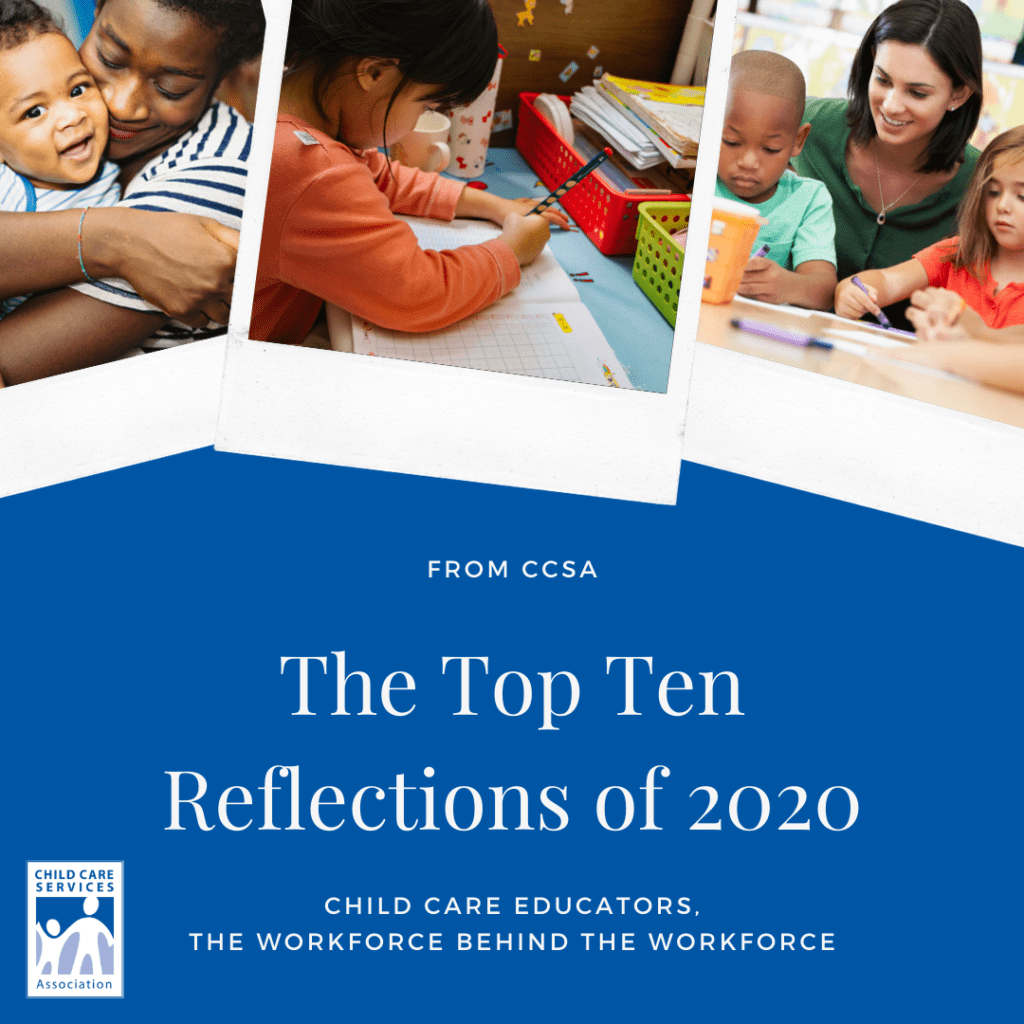When 2020 began, none of us anticipated what a challenging year it would be. The events of 2020 have shaken the world and changed our lives. COVID-19 has affected us all, directly or indirectly, and its impact will be felt for years to come. But with challenges come opportunities for reflection over what we learned—and what was made clear once again—this year.
- Essential workers, families working from home and families returning to work depend heavily on child care programs to keep their children safe and healthy, yet child care programs are still struggling. Child care programs supporting North Carolina’s families have to decide every day between risking their own health to care for children or possible permanent closure. Many programs have had to cut employee hours, lay off teachers or give up on other vital resources. Some closed their doors temporarily.
As the state reopened and child care programs fought to remain open, some parents were left with few options for child care, forcing them to choose between work and their children. Child care programs are still recovering today, with enrollment well below pre-pandemic levels and a shortage of qualified early care and education teachers.
- Child care programs are facing an unprecedented challenge as they meet the needs of our workforce and families returning to work. In response to the pandemic in March, CCSA established its COVID-19 Relief Fund to support the state’s child care programs. Through two phases, CCSA provided more than $260,000 in grants to approximately 750 child care programs in 82 of North Carolina’s 100 counties, helping them get the resources they need to keep the children in their care safe and healthy.
- The child care workforce keeps our economy running. CCSA has always known just how important the child care workforce is for our families and economy, and now communities, parents and employers understand, too, that the child care workforce is the workforce behind the workforce.
- Child care programs are resilient, gritty and adaptable, even with reduced staff, enrollment, funds and other vital resources. Programs adjusted to online early care and education, opened up extra classrooms for school-aged children to do their online schoolwork, supplied computers and books to the children in their classrooms and at home and even fed the families they serve to provide a stress-free and safe learning environment. We’re extremely grateful for the remarkable work of our child care programs and their early childhood educators in order to give children the stability and certainty they need during a time when instability controls every aspect of our lives.
- Knowing where North Carolina was just before the pandemic gives us invaluable information as we plan our path forward to recoup the losses we have sustained. In October, CCSA released the 2019 North Carolina Child Care Workforce Study, giving context to the state of child care before the pandemic. COVID-19 brought to light how essential quality child care is for our economy because it allows parents to work and provides young children with building blocks for future success.
Research on the economics of child care show investments in quality early care and education result in substantial future savings, and research on child development points to the importance of quality child care and a competent workforce, especially for at-risk children. The 2019 North Carolina Child Care Workforce Study is foundational to that knowledge.
- Early childhood educators continue to earn low wages, despite the important work they do for children’s early learning during their earliest years, a time when science shows children’s brains are developing the fastest, setting a foundation for all future learning, including school readiness and school success.
For example, CCSA’s latest workforce study shows child care teachers earn on average about $12/hr. and family child care providers earn $9.09/hr. As a result, turnover is high. Approximately 13 percent of child care teachers work two jobs and more than one-third of the child care teaching workforce relies on public benefits.
- Early childhood educators are leaving their programs for better paying jobs and some are unwilling to return. This creates a perfect storm of chronically low pay and health risks they must face each time they step into their child care programs. These jobs are truly in demand at this time because the field cannot find enough teachers to meet the need, and poverty-level wages are the primary barrier.
- Child care programs still need our support. “While many North Carolina businesses have re-opened, the needs we saw from child care providers in Phase II [of the CCSA COVID-19 Relief Fund] emphasize that the situation on the ground for child care programs hasn’t changed for the better,” said CCSA President Marsha Basloe in October. “The supply of child care depends on a stable and qualified child care workforce, and parents returning to work outside of their homes need access to child care.”
EducationNC reported in December while most N.C. child care providers are open, their status and future are still shaky. About 90 percent of North Carolina child care programs are open, “but the coming months will be especially trying for providers…with relief funds running out, enrollment still down, and coronavirus cases surging.”
- Our experience with COVID-19 offers all of us in the early childhood community an opportunity to re-envision child care in a post-COVID period. To say that the old system didn’t work well would be an understatement. It’s time for a commitment to increase child care educator wages. Child care is essential to the larger workforce; parents cannot go to work without care and education for their children, and specifically, care that they trust.
- Investment in early childhood care and education pays off and it’s measurable (13 percent ROI), and the workforce that supports all other workforces deserves better. It’s time for our government and big businesses to come together and discuss options to fund the salary scale that’s been developed and studied.
“Where there’s a will, there’s a way,” said Basloe. “Let’s commit in the new year to harness that will.”
What would you like to see in the new year?




